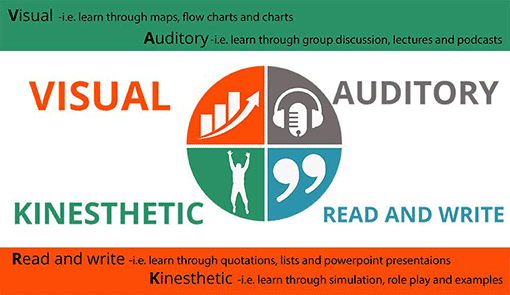We share everything from customer service training activities to ideas for fun coaching games, as we help to freshen up your contact centre coaching programme.
1. Think About the Different Ways People Learn (VARK)
“Contact centres may benefit from putting their advisors through a VARK assessment tool to find out the best way individual advisors learn, before building a programme around each individual employee,” says Helen Pettifer, Director of Helen Pettifer Training.
VARK is an acronym in which each letter stands for a different method of learning. This is highlighted below:

So, if a well-trained team leader knows how an advisor learns best, they can create and recommend learning materials that are tailored to that individual. This means that they can support advisor development in the most efficient way possible.
2. Stop Thinking of Training as Just a Classroom Activity
There are many things that people can do to aid their learning without being in a classroom environment, and this is something contact centres are increasingly thinking about, especially with the growth of flexible working.
It’s hard to get everyone into a classroom together, which isn’t necessarily a bad thing, as it’s testing us to vary the way we communicate with our teams…
With flexible working, it’s hard to get everyone into a classroom together, which isn’t necessarily a bad thing, as it’s testing us to vary the way we communicate with our teams in order to appeal to different learning preferences.
“Classroom learning is not always going to be the best method of learning for everyone, so recognize different learning styles and add variety,” adds Helen.
By thinking of learning differently, we can take people away from just doing what they are used to by making sessions more interesting, which helps our key messages to become more memorable.
3. Teach Team Leaders to Help Advisors to Spot Their Own Skill Gaps
While it is hard to admit when there are gaps in your learning, it is part of a team leader’s job to create an environment where people are confident to share.
As Helen says: “Encouraging autonomy with their own personal development, by getting advisors to identify the gaps in their own skill sets and to say what they find challenging and where they need to improve is key to making training stick.”
Getting advisors to identify the gaps in their own skill sets and to say what they find challenging and where they need to improve is key to making training stick.
One good initiative to help with this is advisor self-scoring, as they can fill in a scorecard alongside the team leader and discuss the variations in their assessments.
We just need to remember to be positive with our feedback, using the right training models, so it’s not seen as an exercise to “catch advisors out”.
As team leaders, we should also be thinking about the advisor’s goals within the organization and what they want to achieve in later life, to best tailor their development.
4. Hold Facilitated Discussions to Share Best Practices
“Let advisors take the lead in facilitated discussions and focus groups by sharing their experiences and encouraging others to do the same, to compare what they do in certain situations,” says Helen.
With these focus groups, you are encouraging open discussion of how to improve, helping you to create a culture of learning.

With these focus groups, you are encouraging open discussion of how to improve, helping you to create a culture of learning.
Also, we encourage advisors to take on a leadership role. This will also help you in identifying which advisors may be best suited to a team leader position, when such a position arises.
Just remember to have a coach or a team leader to facilitate the discussion, so practices that may not be in the best interests of the customer don’t spread. This is their key role. Otherwise, they just ask an open question, sit back and let the conversation build.
For more exercises like this, which are better suited to remote working, read our article: 10 Fun Customer Service Activities That Will Make Your Staff Smile
5. Celebrate Success to Get Everybody Enthusiastic About Learning
Recognition is key to refuelling advisor motivation and, to do this, it’s key to actively celebrate advisor successes, even if it’s just with a thank you, a “call-out” in a team huddle or a certificate.
Helen says: “At the end of my training courses, I give out a certificate and everyone really appreciates it. While, to me, it’s just a piece of paper, to them it signifies that they have achieved something.”
At the end of my training courses, I give out a certificate and everyone really appreciates it. While, to me, it’s just a piece of paper, to them it signifies that they have achieved something.
These little somethings often mean a lot, as they underline little successes, and if we make a big deal of these successes, we can generate enthusiasm.
So, by creating many different levels for how advisors are rewarded for quality and behavioural things, we can create a culture that celebrates learning, which can be invaluable.
For insight into how to create a reward scheme that supports advisor development, read our article: How to Improve Your Employee Reward Schemes – With Examples
6. Add in Fun Energizer Activities to Get People off Their Feet
It’s really important to get advisors up and out of their chairs, to help get the team out of their routine of coming in and sitting at their desk. We want to engage them early!
We want to get the energy flowing by getting the body moving – especially after lunch, when everyone comes back and they are in that middle-of-the-day slump.
As Helen explains: “We want to get the energy flowing by getting the body moving – especially after lunch, when everyone comes back and they are in that middle-of-the-day slump. This is where we can get great value from freshening things up.”
Sky’s contact centre in Stockport runs energizer activities first thing in the morning, where, in the first 10-15 minutes of the day, advisors play team building activities to liven up the atmosphere from the get-go.
Activities are designed personally by Sky’s Contact Centre Manager to encourage continuous coaching, knowledge development and to strengthen the team dynamics.
7. Role-play Different Scenarios With an Observer
Having the opportunity to role-play and practise how to deal with certain scenarios is great for induction training, as it gives new recruits a real taster of what being an advisor is really like.

Helen Pettifer
To get even more value from role plays, Helen recommends: “Bring in a third person, so there’s a customer, advisor and an observer. The observer is then looking at both sides of the conversation, analysing and reflecting, before giving feedback at the end.”
While this is a great process, it doesn’t necessarily have to stop once the advisor finishes their induction, as role plays can help advisors to continuously learn. Once advisors get to this stage, it is, however, better to allow them to choose which scenarios they want to enact.
This is according to Helen, who says: “I have found it to work better when advisors role-play real-life situations, as what they choose to role-play will be what’s most relevant to them.”
8. Create Interactive Webinars as a Team
Earlier we presented the VARK model, which helped you determine how your advisors learn best. Yet certain tools, such as webinars, are a great ways to connect with a number of different learners.
Webinars offer a great opportunity to be innovative, and if we think creatively about how we put them together, we can create really engaging learning materials.
“If you have a number of different teams, they can each be tasked with putting a webinar training course together as a team activity, which can then be spread across the contact centre,” adds Helen.
By including members of the team in creation, we can mix up their role, make them experts in one key area and exploit their creativity, to try and add that little extra fun.
To gain some webinar innovation ideas, take a look at our recent recorded webinars.
9. Spend Time With Charities to Build Advisor Empathy
Getting employees out in the community, volunteering with charities and interacting with people who they wouldn’t ordinarily interact with is great in terms of building soft skills.
Helen says: “Who is your target audience? Who are advisors interacting with on a daily basis? If we can go out and meet them in their own environment, that really encourages empathy skills.”

Who are advisors interacting with on a daily basis? If we can go out and meet them in their own environment, that really encourages empathy skills.
If you have a specialist team to which you route calls from vulnerable customers, this experience with charities can be incredibly enlightening, as we can better understand the situations that certain people may be struggling with.
Also, when we go out into the local community, advisors will see the positive impact that they can have in the area they live in. This may increase their sense of pride in what they do, which is great in improving overall engagement levels.
10. Create an Action Plan After Each Training Session
Before each training session, it is good to set some goals and objectives, but we also need to think about how advisors put these into practice.
After a big training session, ask advisors to create an action plan about how they are going to put their new skills into practice.
So, Helen recommends: “After a big training session, ask advisors to create an action plan about how they are going to put their new skills into practice.”
We should also be following this up and asking advisors to share an example of when they practised their new-found skills in their next quality monitoring session.
Just remember to set these objectives and to create action plans when you run informal training sessions too – e.g. sending advisors to spend time with charities. This is because we want advisors to share what they’ve learned with other people and to put those lessons into practice.
11. Try out a Lunch-and-Learn Training Session
Short bite-sized lunch-and-learns are particularly memorable ways to help people learn.
“People let their guard down that little bit more in lunch-and-learn sessions because it’s informal. By getting away from a classroom and eating together you are creating a sharing environment,” adds Helen.
People let their guard down that little bit more in lunch-and-learn sessions because it’s informal. By getting away from a classroom and eating together you are creating a sharing environment.
So, in these sessions, advisors will be more comfortable sharing information, experiences and knowledge.
Even though you may think about the costs of providing food for everyone, you are using some advisor break time for a more productive purpose.
These lunch-and-learns are great for increasing engagement when running focus groups for both advisors and your customers.
12. The Lost at Sea Training Game
One team-building game that Helen plays with customer service teams, to help grow problem-solving skills, is a game called “Lost at Sea”.
To play this game, participants are given a “lost at sea” scenario and a list of 15 items. Split into teams of five, each team member individually ranks each of those items in terms of its importance to helping them to survive the scenario they are given.

The aim of this game is to improve the team’s ability to analyse information, their decision-making and their cooperation with one another…
The individuals in the team then come together to compare their lists, discussing any differences in rankings and deciding a final ranking as a team, creating a combined top 15 list.
Then the combined top 15 list is compared with the top 15 list of the coach, who will explain their reasoning, discuss differences and actively recognize good logic within the team’s rankings.
The aim of this game is to improve the team’s ability to analyse information, their decision-making and their cooperation with one another, in order to achieve the best possible results.
For more fun training activities like this, read our article: 9 Fun Customer Service Training Exercises
13. Use Checklists to Develop Advisor Listening
While active listening may seem like a simple enough skill, when taking numerous calls across the day, it can be difficult to stay completely focused on what the customer is saying.
Listening is also a skill that is much more difficult on the phone than in person, as clues to the customer’s mood, such as body language and eye contact, are hidden.
So, creating a checklist for new advisors to follow helps to bring attention to all the soft skills that are needed when listening to the customer over the phone, and Helen suggests including statements like the following in your version:
- I listen actively and do not think of what I am going to say next while the other person is speaking.
- I ask probing questions to make sure that I have been understood.
- I listen carefully for certain words that reflect how the customer is feeling.
We can also play fun exercises to find other ways of training advisor listening, like those included in our article: How to Train Active Listening in the Contact Centre – With Four Exercises
14. Make Use of Advisor Strengths
Multiskilling advisors, so they can handle a number of different contact reasons, can be great in terms of workforce efficiency. But we mustn’t forget where people’s strengths lie.
“When we identify people’s strengths, we can utilize their talents in certain areas and share their expertise with the rest of the team,” says Helen.
By showing trust in advisors to share their key skills, we can increase engagement and improve their personal development, while it also grows respect for one another’s skills amongst the team.
It is also best not to think of multiskilling as the be all and end all. Constantly switching between one topic and another may actually cause handle times to increase. So focusing on improving contact routing strategies maybe an even better tactic.
15. Play With e-Learning and Highlight Key Learning Areas
You can use e-learning to run fun quizzes, display training progress and schedule sessions to fit in with quieter periods, in order to help engage advisors with team training.
“With e-learning, people can work at their own pace and go back if they haven’t understood something, helping the contact centre to personalize learning and development,” adds Helen.
With e-learning, people can work at their own pace and go back if they haven’t understood something, helping the contact centre to personalize learning and development.
If you don’t wish to invest in e-learning software, it can be good to build a virtual “work library”, which would go alongside your knowledge base.
So, if you allocate 30-45 minutes a week for individual learning, an advisor could perhaps listen to an audio book, log on to the online portal or watch some video tutorials, choosing whichever learning method best suits them.
For more on applying e-learning software to customer service, read our article: The Best Uses for e-Learning in the Contact Centre
16. Spend Some Time in an Escape Room
Getting the team out of the contact centre on trips can be very helpful, as taking them out of the work environment will help to improve team cohesion. By picking the right trip option, we can gain even more benefits.
One trip option that Helen is a big fan of is escape rooms, which help to build problem-solving skills amongst the team, as everyone works together, creating unique memories.
Helen says: “Just think outside the box of how you can bring the team together to share knowledge and skills, as well as just bonding – as the team get to understand one another better.”
We want to remove that corporate feeling, to help the team to make meaningful bonds. So, while an escape room is one idea, encouraging the team to come up with their own ideas is good practice. This will increase their buy-in towards whichever activity is chosen.
For mores for how you can think outside of the box, in terms of coaching advisors, read our article: 5 Ways to Rethink Contact Centre Training
For even more customer service training ideas, read our articles:
- 50 Call Centre Training Tips
- How to Coach Empathy in the Contact Centre – With Three Training Exercises
- How to Achieve Excellent Customer Service Through Coaching
Author: Robyn Coppell
Published On: 4th Dec 2019 - Last modified: 18th Aug 2025
Read more about - Call Centre Management, Editor's Picks, Employee Engagement, Fun and Games, Helen Pettifer, Management Strategies, Training and Coaching















